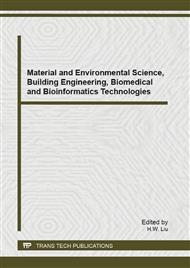p.587
p.590
p.594
p.598
p.607
p.611
p.615
p.619
p.623
Study on Apoptosis of Human Promyelocytic Leukemia HL-60 Cells Induced by Fucosterol via Death Receptor Pathway
Abstract:
The purpose of this study is to investigate the effect of fucosterol on the induction of apoptosis and the molecular mechanism involved in Human promyelocytic leukemia HL-60 Cells. HL-60 Cells were treated with different concentrations of fucosterol at different time. MTT method was used to study fucosterol anti-tumor activity. Morphology observation was performed to determine the effects of fucosterol on apoptosis of HL-60 cells. Flow cytometry (FCM) was used to detect the cell cycle. Laser scanning confocal microscope (LSCM) was used to analyze the expressions of Fas, FasL, Fadd and Caspase-8. Caspase activity kits were used to determine the activity of Caspase-8 and Caspase-3. The results showed fucosterol could inhibit the growth of HL-60 cells, and the apoptosis morphology for 48 h treatment was obvious, which showed cell protuberance, cytoplasm concentrated and apoptotic body. Fucosterol treatment for 24 h increased the protein expression of Fas, FasL, Fadd and Caspase-8. It also showed that the activity of Caspase-3 and Caspase-8 has increased significantly. In conclusion, Fucosterol could induce HL-60 cells apoptosis via death receptor pathway.
Info:
Periodical:
Pages:
607-610
Citation:
Online since:
September 2013
Authors:
Price:
Сopyright:
© 2013 Trans Tech Publications Ltd. All Rights Reserved
Share:
Citation:


